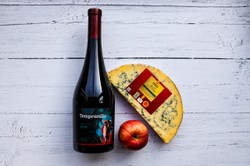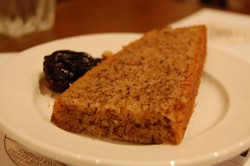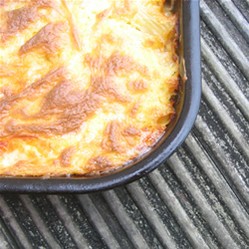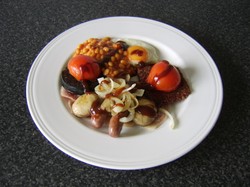1: The simplest is fresh cheese, and it is the most low tech. It is closely related to the cottage cheese that I made and described above. Simply sour the heated milk by using rennet, ladle the curds into moulds, and consume within a week. To aid consumption blocks of this cheese are small. As it is not matured long enough to harden, it is a soft, often crumbly cheese. It goes well with biscuits, which we British call crackers, and also goes well in salads. I like it on toast. If you are taking it with wine, a light white wine is ideal.
2: Mould-ripened cheeses, such as camembert and brie, have the milk infected with Penicillium camemberti. A variety of organisms get into the mould, but the cheesemakers overwhelm the rest by flooding the mould with Penicillium. This enables them to get the desired effect, which is a rind that coats the cheese. These cheeses go well with a light, fruity red wine.
3: Washed rind cheeses. These have a bacterial rind which is achieved by killing off the fungal moulds. This is done by washing them in brine, but many are then washed in one of a variety of alcoholic drinks. The result is a pinkish, sticky rind which gives the cheese its flavour. Cheeses of this type are smelly, as the microbes give off ammonia when ripening. The French call the smell "the feet of God." One British example is Celtic Promise, which comes from Ceredigion in West Wales. Washed rind cheeses go well with a good Burgundy or a dark beer.
4:Blue Cheeses. I have already mentioned how they are made, but it is important to add that it is necessary for them to have some degree of softness about them so that the mould's penetration will not be impeded. There are two outstanding examples of blue cheese. One is Stilton, produced only in certain English creameries and known as a queen among cheeses. Another is the Irish cheese Cashel Blue, made in the lovely vale of Tipperary. Enjoy these with a good port, though I have had these cheeses with white wine and enjoyed them.
5: Semi-soft cheeses. This is a broad category that contains instances of others in it. To make a semi-soft cheese heat the curd to release more whey, the residual liquid left over from cheese- making. Semi-soft is a good category for mixing fruit into the cheese, as hard cheese would squash the fruit too much. Wensleydale is a good example of a semi-soft cheese. A variety of wines go well with these cheeses.
6: The quintessential hard cheese is cheddar, but it is not too hard too be enjoyed. This kind of cheese stores well. It can be mixed with flavourings. I have one in the fridge flavoured with Irish whiskey. I have also eaten cheddar with cooked nettles, which lose their sting when boiled. The nettle leaves are gathered in Spring, diced, cooked and added to the curd. The cheese tasted very good.







 TheThousand Year Garden28 days ago
TheThousand Year Garden28 days ago
 Women of the Gospelson 10/11/2025
Women of the Gospelson 10/11/2025
 Religious Gardenson 08/25/2025
Religious Gardenson 08/25/2025
 Doctor of the Church: John Henry Newmanon 08/03/2025
Doctor of the Church: John Henry Newmanon 08/03/2025




Comments
I have just found a new cheese, or rather a cheese new to me, Cornish Blue. Maureen went to the Good Housekeeping Show in London and brought me a git of a block of cheese at the Christmas market, which was run by Country Living magazine. The cheese is a lovely eat, The blue taste is strong and pleasantly salty. I commend it to readers.
Skyr is known over here, but it is not common. We tend to prefer cattle derived cheeses, but feta, ewez's milk, is very popular.
Thank you for your comment below, on Jan. 13, 2024, in answer to my previous, same-day observation and question.
In another direction, related because about cheese, ancient, modern and traditional Icelanders appreciate sheep products such as their better-than-yogurt skyr. That product counts among exports to the Unitedstatesian side of the Atlantic pond.
But Unitedstatesians imported-cheese lovers demand their skyr as cattle- not sheep-derived.
Do you know if skyr exists as a British Isles-er import from Iceland?
I think that it would be a very specialist imported cheese.mi will look it up for you. Harrods could probably getvitbfor you,but it would be very expensive.
Yesterday evening a young couple had the parking space next to us at the grocery store. They had a most attractive, well-behaved, wide-eyed sentient whom they identified as a 12-day-old goat.
The young goat made me ponder other cheeses and your cheeseboard wizzley.
That wizzley's second paragraph to its first subheading, Overview, notes mare's cheese which "is not made at all anywhere in Europe."
Would mare's cheese be purchasable in the British Isles?
I do not eat non dairy alternatives. I love milk and all products made from it.
This comment begins like it's in an unrelated direction but it actually is related to your cheese expertise.
Non-dairy alternative drinks and yogurts count more with me these days than their dairy counterparts. For example, I drink almond, cashew, coconut milk, not moo-lk ;-D.
Would you happen to know of any non-dairy alternative cheeses that you find nutritious and tasty? I would rather continue my love for traditional dairy cheese but some -- not the ones you, Veronica and I have discussed below -- are not quite as appealing as they once were.
Thank you!
Nettles grow in clean, convenient places in the yard. Your recipe is eminently do-able because of the clear explanation.
Let me ask two more questions: Is there a particular kind of goat's cheese that you like or recommend? And what kind of salt -- sea? -- would you be using on the cheese?
Making your own cheese with nettles is easy. Make a cottage cheese, which should take only a few days. Pick the new, young leaves from the top of the nettles. Drop them into boiling water for five minutes to destroy the sting. Strain off the water. Dry the nettles. Shred them, then sprinkle them into the still liquid cheese. Eat when ready. Don't eat old nettles, they have too much oxalic acid in them.
Nettles are rich in nutrients. You will need to add some salt to the cheese, but nettles themselves are quite salty.
I like goat's cheese with nettle shredded and mixed into it,but Cornish yard has no shredded nettles.It ìs wrapped all round with nettle leaves, which flavour the rind.